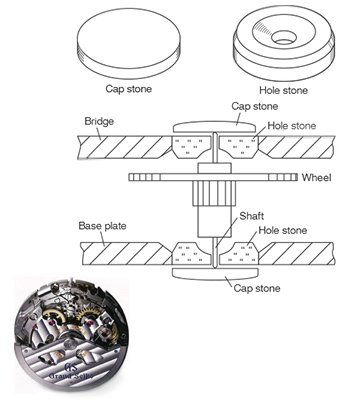
When you look at a catalog of mechanical watches, you will see the description of the number of stones. How are watches and stones related? As a matter of fact, a stone is one of the important parts in watches.
In the movement (machinery system) of a mechanical watch, the parts with a vertical shaft, such as gear wheels and balance wheel, are secured between the base plate at the bottom and the bridge at the top. It is like the parts are sandwiched between the base plate and the bridge, supported by their shafts.
The shafts execute rotary or back-and-forth movement while being in contact with the bridge and the base plate at the top and bottom, respectively. Therefore, the areas with which the shafts are in contact are required to withstand wear so as not to reduce their accuracies or fail.
To achieve this, a stone is used as an end. A synthetic ruby, sapphire, or other hard stone are used, which are durable enough to have a high friction resistance. By covering it with oil for protection, the gear wheels and other parts move accurately at all times while the oil is retained for a long time. There are some cases where the escape wheel and balance wheel use four stones, which have two hole stones around the shaft, and two cap stone, which have no holes, at the top and bottom, respectively. In addition to the shafts, synthetic jewels are used as stones for the pallet folks, and impulse pin which wear easily.
Generally speaking, more stones are required in higher-class and more complicated mechanical watches although minimum 17 stones are good enough for functionality. For example, Grand Seiko High Beat uses 37 stones.


